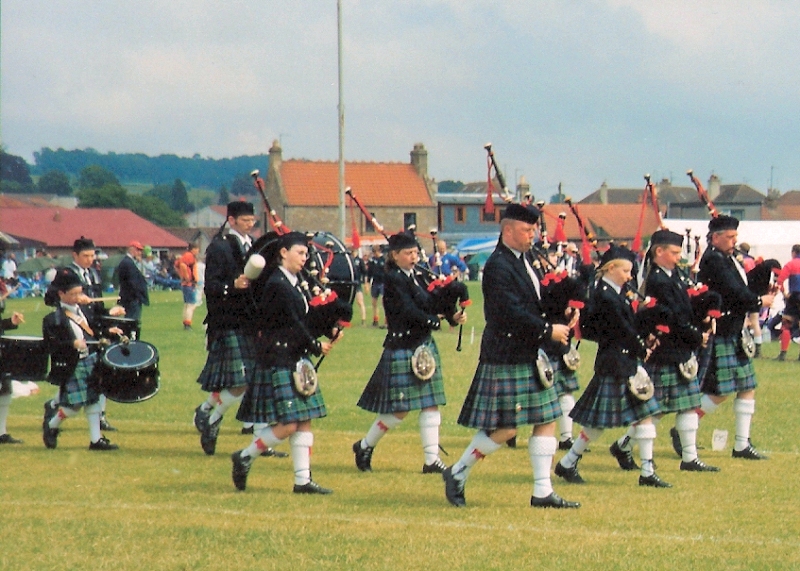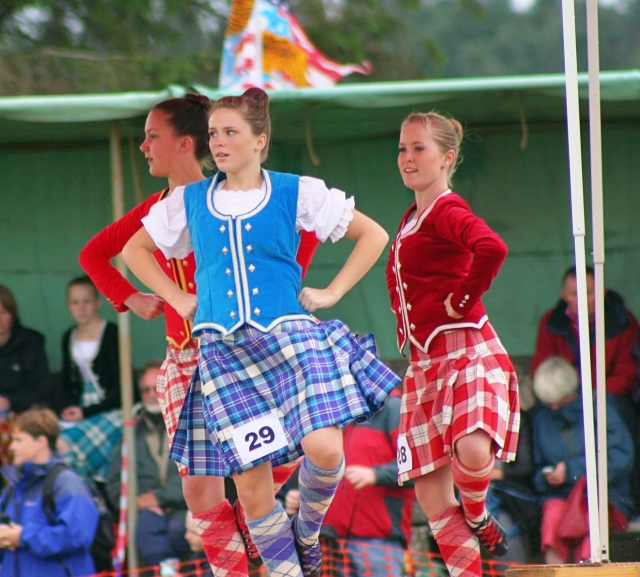
We hear pipes and drums in the distance, and the announcer states that the parade, led by the Chieftain of the Games, will be arriving in the arena soon, having made their march through town. These are the pipers that we saw in the car park at the other end of town. Just as the pipe band, followed behind by all of the Highland Dancing competitors, arrives, the sun breaks through the clouds sending bright rays angling down on the festivities. I look at my watch. It's 1:30; the sun has appeared right on schedule.
Our backs and legs are aching from standing in one place too long, so we make another circuit around the track. The savage-looking character in Highland dress is manning a table selling chances for items spread out before him, to support his chosen cause. He has obviously heard our accents, pegging us as tourists, and strikes a pose. He then steps away from the table for a little chat.
I have no problem at all understanding what he's saying, though his accent is quite thick. Perhaps he's speaking slowly to accommodate me. He asks where I'm from and then sails into a tale about a friend of his who moved to Kansas. He is very friendly and talkative, the complete opposite of the stern countenance he presents. I smile, thinking that Kansas is further away from where I live than the entire length of this wonderful island on which I now stand.
We return to the piping competition, sharing a snack of donut nuggets that have been fried, then shaken in a bag of sugar. These are wonderfully warm but make our stomachs aware that it's getting toward that time of day where food is in order. Leaving the festival area in search of a loo and a pub, we share a laugh with the lad who stamps our hands so we can get back in without paying the entry fee again. He tells us, with mock severity, that he'll be checking to make sure the stamp is blurry when we return – proof that we've washed our hands.
Dana and I swing on the swings in the deserted park area for a few moments before heading back to the festival. We seem to have seen all there is to see for the moment and lunch is in order. Not having seen any pubs in town, and it being Sunday and now well past the normal 2:00PM cut-off for lunch that we've found in most places during our trip, we make a completely spontaneous decision to leave Cupar behind and journey on to St. Andrews to a pub Dana remembers from her visit there last year. St. Andrews is one of Dana's favorite places. Her recommendation for Culross was certainly on the mark, so I'm game.
Completing our final circuit around the arena, we stop and watch Bubba Hamish twirl and throw a 28-lb. hammer 275 yards. We then stop and ogle the lad in short-shorts one last time as he digs his heels in and gives a good yank on the rope in the tug of war competition, which seems never ending. I realize later, while reading the program we were handed when we paid our admission, that this is the Scottish Tug of War Championship. These lads have traveled here to compete from all over the country.

Highland dance is a style of competitive solo dancing developed in the Scottish Highlands in the 19th and 20th centuries in the context of competitions at public events such as the Highland games. It was created from the Gaelic folk dance repertoire, but formalized with the conventions of ballet, and has been subject to influences from outside the Highlands.
Highland dancing is often performed to the accompaniment of Highland bagpipe music and dancers wear specialized shoes called ghillies. It is now seen at nearly every modern-day Highland games event.
Highland dancing is a competitive and technical dance form requiring technique, stamina, and strength, and is recognised as a sport by the Sport Council of Scotland.
Read more about Highland Dance at Wikipedia.